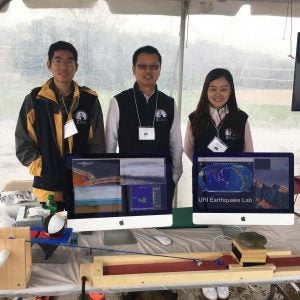 We all know our planet spins, but did you also know it is constantly changing.
We all know our planet spins, but did you also know it is constantly changing.
Earth’s outer crust moves in pieces over melted rock, coming together and spreading apart to reshape the geological landscape.
Those interactions—called the theory of plate tectonics—can cause natural disasters, including earthquakes, which are especially destructive. It’s crucial, then, that scientists understand them.
Unfortunately, quakes are not easy to study, much less predict.
Matt Wei, a geophysicist at the University of Rhode Island, is taking on the challenge, thanks, in part, to a grant from the National Science Foundation.
Wei, 36, of Wakefield, R.I., has received $600,000 from NSF’s Faculty Early Career Development Program, a prestigious initiative that supports junior faculty members throughout the country.
“I’m deeply honored,” says Wei. “I’m pleased the National Science Foundation has recognized the value of researching large earthquakes. Ultimately, our goal is to better forecast them and save lives.”
In his lab at the Graduate School of Oceanography, Wei is studying earthquakes beneath the ocean bottom to learn more about earthquakes on land.
Studying significant earthquakes on land is difficult for scientists because they can happen infrequently on the same fault line, says Wei.
“There are some faults on land that rupture every few thousand years,” says Wei. “In 2008, there was a big earthquake in Sichuan Providence, China, and scientists have estimated that the last one on that fault was 4,000 years ago.”
As the result of the long interval, modern instruments have only captured a snapshot of the earthquake cycle on land, says Wei. With limited data, he says, scientists have trouble validating models of the earthquake cycle.
The ocean provides better data. Some faults in the ocean rupture much more frequently, sometimes every five years. Many of those quakes are off the coast of Mexico in the Pacific Ocean—a region that Wei studies.
“Because these earthquakes occur more often, we are able to gather information that may detect patterns in earthquake occurrence,” says Wei. “This data is important to validate our three-dimensional computer model.”
His results, he says, might help scientists better understand faults on land, such as the San Andreas Fault in southern California—long overdue for a major earthquake that could impact more than 20 million people.
The San Andreas fault extends about 750 miles through California. Many cities and towns along the fault have been hit by earthquakes over the years, and scientists predict that another big one in southern California could happen soon.
“It could be tomorrow—it could be 30 years from now,” says Wei. “We don’t know. That’s why we need to do more studies to improve our understanding of what causes these faults to rupture.”
Wei’s grant will also support outreach activities to educate college and high school students, as well as the public. A software package that simulates earthquakes will be available to the public and scientists.
Wei and two graduate students, Pengcheng Shi and Bing He, both from China, demonstrated how earthquakes work during the recent open house at GSO. The team used computer models and an earthquake machine, which it built in Wei’s lab.
“Many people, especially kids, were fascinated,” says Wei. “We were happy to be part of this outreach effort and share our research. Maybe a budding geophysicist was in the crowd.”
Wei, a native of Xiangyang, China, received his bachelor of science degree in geophysics from Peking University in Beijing in 2004 and his doctorate in Earth sciences from the Scripps Institution of Oceanography at the University of California, San Diego in 2011. He joined URI as an assistant marine research scientist in 2013 and was appointed assistant professor in the fall 2016.
“I’m lucky to be around excellent colleagues, and an intriguing and supportive academic environment,” Wei says. “I expect my research on earthquakes to continue in the coming years, and make useful contributions to the field.”
Photo caption: Pengcheng Shi, GSO graduate student (on left); Matt Wei, URI oceanographer (in middle); and Bing He, GSO graduate student (on right). Photo courtesy of Matt Wei.
Media Contact:
Elizabeth Rau
401-874-2116
